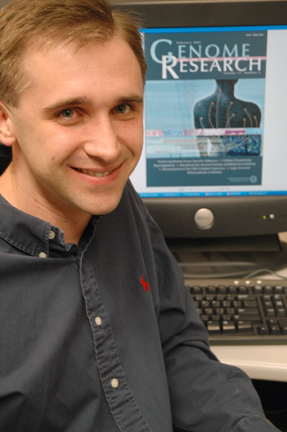| T H E N I H C A T A L Y S T | J U L Y – A U G U S T 2007 |
| | |
On Tenure Track
 |
| Ivan Ovcharenko |
Ivan Ovcharenko is devising computational methods to cut through the so-called junk DNA in the human genome to find generegulatory elements concealed within.
He joined the NCBI's Computational Biology Branch this year after working as a scientist at the Lawrence Livermore National Laboratory in Livermore, Calif., for four years. With only about two percent of the three-billion-letter human genetic code known to correspond to proteins, his task of identifying and characterizing elements that regulate genes, hidden somewhere in the remaining 98 percent of the human genome, appears arduous.
But Ovcharenko has had some early success in applying evolutionary comparisons and sequence pattern analysis techniques to predict the location of gene regulators in so-called gene deserts—megabaselong stretches of DNA completely devoid of protein-coding genes.
Ovcharenko, who holds a doctorate in physics and mathematics, conducts his research much like a theoretical astrophysicist, using keen insight and computational muscle to predict patterns in nature and then partnering with molecular biologists to test his theories.
He and his colleagues from the University of Chicago and the Lawrence Berkeley National Laboratory in Berkeley, Calif., for example, have devised a computational strategy to identify regulatory elements governing heart development during embryogenesis and to test them in vivo in transgenic mouse and zebrafish embryos. Encouragingly, many of the predicted elements were found to be driving gene expression in the heart region of developing mice and fish.
Ovcharenko uses gene-expression profiling, transcription factor binding- site analysis, and comparisons among vertebrate genomes to decipher sequence signatures for tissue-specific enhancers and repressors in the human genome. A major motivation for coming to the NIH was "the possibility to establish collaborations with researchers doing molecular biology and clinical studies," he said.
He sees a direct link between understanding the genomic encryption of gene regulators, often referred to as the second code of genomes, and developing disease screening techniques and ultimately cures, provided he gets together with the right bunch of researchers.
Ovcharenko is now working with researchers in NICHD, among other ICs. An overview of his recent work is captured in a cover article from February 2007 in Genome Research entitled "Predicting tissue-specific enhancers in the human genome."
-by Christopher Wanjek